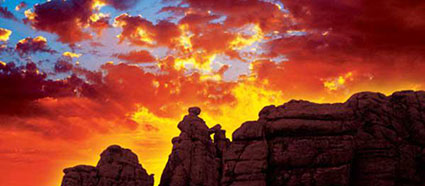
Located at 25 kilometers north of the Arxan city, the Rose Peak is a scenic spot with a total area of 82 square kilometers comprising of more than 10 stone peaks. It is a typical landscape of granite stone forest. The stone peaks that form the scenery are intertwined with each other but in a regular pattern. The towering peaks are both grandiose and spectacular. They are called the“Rose Peak”or the “Red Boulder”because most peaks are in mahogany color.
More than 154 million years ago, the rock underlying these peaks is formed in a deep underground magmatic movement, and later the landscape that we see here today is created with the constant lifting of granite to the surface by geological movement and years of erosion through rain and shine. The granite as a whole that forms the Rose Peak is characterized by the horizontal and vertical joint development. The vertical joint development is especially conspicuous, and the occurrence is an inclination of 113 degrees in an angle of 75 degrees. The reason is that when the rock rises then to the surface and forms independent hills, the cracks in the rock are in an unbound and free state. Later with the physical and chemical action of the nature, the rock fragments continue to flake along the cracks, and form “stone pillars” of varied sizes in the direction of the vertical cracks, and general stacks that seem to be hand-made along the horizontal cracks.
In the flat area on top of the granite stone forests in the Rose Peak, there is also developed a “stone mortar” featuring a slightly smaller mouth, a larger belly and a fairly flat bottom or the shape of a dimpled pan. These mortars on the plane are generally oval, round, spoon-shaped, or irregularly semi-circular, etc. They look like mortars or jars, or appear to be drums or discs. There are no water inlets around the mortars, but water outlets in the low-lying places. Controversial opinions exist on how these mortars are formed. Those who attribute their formation to glacier call them “ice mortars” while those who attribute their formation to wind would like to call them “potholes.”
 Service Hotline:(086) 4000-151-757
E-mail:nmgaes@126.com
Service Hotline:(086) 4000-151-757
E-mail:nmgaes@126.com
